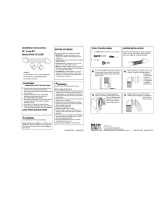
REMOVE GROUND STRAP AND DISCARD
KEEP GREEN GROUND SCREW
RELOCATE GREEN GROUND
SCREW HERE
strain relief
bracket
HOT
NEUTRAL
(white)
3/4", UL
recognized
strain relief
HOT
• Remove the cover near the power cord entry hole.
• Install 3/4" UL recognized strain relief to power
cord entry hole. Bring power cord through strain
relief.
• Connect two HOT lines to outer screws (L1 & L2)
of terminal block.
• Connect NEUTRAL (white) line to center screw (N)
of terminal block.
• Attach ground wire of the power cord with the
green ground screw (hole above strain relief bracket).
• Tighten all terminal block screws firmly.
• Properly secure power supply cable to strain relief.
• Reinstall the cover.
CONNECTING DRYER USING 4-WIRE CONNECTION
REAR EXHAUST LOCATION
The dryers come ready for rear exhausting. Units
have separate exhausts.
EXHAUST LENGTH
EXHAUST INFORMATION
MAXIMUM LENGTH
EXHAUST
– HOOD TYPE –
A B
NUMBER
OF 90˚
TURNS
RIGID METAL DUCT 0 45 ft. 30 ft.
35 ft. 20 ft.
4" DIAMETER 2 25 ft. 10 ft.
PARTS AVAILABLE FROM LOCAL SERVICE
ORGANIZATION
• Rigid Metal Duct Components
WX8X63 4" X 1' Duct
WX8X64 4" x 2' Duct
WX8X51 4" Elbow
WX8X59 4" Aluminum Hood
• Flexible Metal Duct Components
WX08X10077 4" dia. flexible metal (semi-rigid)
UL-listed transition duct (includes 2 elbows)
CAUTION: For personal safety this appliance
must be properly grounded.
WARNING :
Never leave the terminal block without the cover.
WARNING: Only a 4-conductor cord shall be used when the
appliance is installed in a location where grounding through the
neutral conductor is prohibited. Grounding through the neutral is
prohibited for the new branch-circuit installations, mobile homes,
recreational vehicles, and areas where local codes prohibit
grounding through the neutral conduction.
The MAXIMUM ALLOWABLE duct length and number of
bends of the exhaust system depends upon the type of duct,
number of turns, the type of exhaust hood (wall cap), and all
conditions note below. The maximum allowable length for
rigid metal duct is shown in the
table below. More than two 90˚
turns is not recommended. The
total length of flexible metal duct
shall not exceed 8 ft.(2.4 m). In
Canada and in the United States,
the required exhaust duct diameter
is 4in (102mm).
WARNING - TO REDUCE THE RISK OF
FIRE OR PERSONAL INJURY:
Provide an access for inspection and cleaning of the
exhaust system, especially at turns and joints.
Exhaust system shall be inspected and cleaned at
least once a year.
–
Do not obstruct incoming or exhausted air.
–
Do not assemble ductwork with any fasteners that
extend into the duct. These fasteners can accumul-
ate lint, creating a potential fire hazard.
–
In special installations, it may be necessary to connect
the dryer to the house vent using a flexible metal (foil-
type) duct. A UL-listed flexible metal (foil-type) duct
may be used ONLY in installations where rigid metal or
flexible metal (semi-rigid) ducting cannot be used AND
where a 4” diameter can be maintained throughout the
entire length of the transition duct. In Canada and in
the United States, only the flexible metal (foil-type)
ducts that comply with the “Outline for Clothes Dryer
Transition Duct Subject 2158A” shall be used.
–
Never install a screen in or over the exhaust duct.
This will cause lint to accumulate, creating a poten-
tial fire hazard.
–
Do not use duct longer than specified in the exhaust
length table. Longer ducts can accumulate lint,
creating a potential fire hazard.
–
Never terminate the exhaust into a common duct
with a kitchen exhaust system. A combination of
grease and lint creates a potential fire hazard.
–
Do not terminate exhaust in a chimney, a wall, a ceil-
ing, gas vent, crawl space, attic, under an enclosed
floor, or in any other concealed space of a building.
The accumulated lint could create a fire hazard.
–
Use only 4” rigid metal or UL-listed flexible metal
(semi-rigid or foil-type) duct to connect the dryer to
the home exhaust duct. It must be installed in
accordance with these instructions and local codes.
–
Use only 4” rigid metal ducting for the home exhaust
duct.
–
This clothes dryer must be exhausted to the outdoors.
–
4 #10 AWG MINIMUM COPPER CONDUCTORS OR 120/240V 30A
POWER SUPPLY CORD KIT MARKED FOR USE WITH DRYERS &
PROVIDED WITH CLOSED LOOP OR SPADE TERMINALS WITH
UPTURNED ENDS (NOT SUPPLIED).





